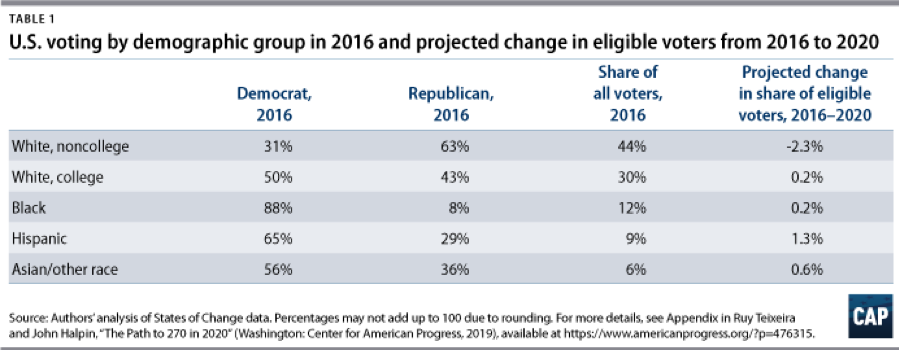Demographics and the U.S. Presidential Election of 2020
Welche Wählergruppen muss der erfolgreiche Kandidat bei den US-Wahlen im November für sich gewinnen, um ins Weiße Haus zu kommen? Eine Analyse von John Halpin und Ruy Teixeira vom Center for American Progress gibt Einblicke in das demographische Gefüge, das die Wahl entscheiden wird.
The state of U.S. politics is obviously deeply in flux as the country and others around the world deal with the simultaneous shocks of battling the coronavirus pandemic and rising economic chaos. We simply don’t know how these developments will affect the fall campaign between President Trump and likely Democratic nominee Joe Biden.
But stepping back from this uncertainty, we do have some basic empirical evidence of what both political parties face in terms of the demographic landscape of the election. The analysis presented below is adapted from a longer report by Ruy Teixeira and John Halpin entitled, “The Path to 270 in 2020”, available at the Center for American Progress website.
Looking back at the 2016 election, Donald Trump failed to command a national majority, losing the popular vote to Democratic nominee Hillary Clinton by nearly 3 million votes and more than 2 percentage points nationwide (48.2 percent to 46.1 percent). More importantly, Trump did manage to capture enough states with high concentrations of white non-college voters to produce an official Electoral College victory of 304 votes to 227 votes. Declines in Democratic turnout and support rates among key constituencies in Florida and the Great Lakes states magnified Trump’s ability to motivate new voters and to convince a considerable number of former Obama voters to back his nationalist message on the economy, immigration, elites and the media, as well as racial and gender divisions in the country.
The big question heading into 2020 is whether President Trump and Republicans can repeat this success. Is there a strong and growing Trump coalition that can replicate his successes with base Republicans and party switchers from 2016 and possibly expand to other places with additional voters?
In 2016, Hillary Clinton built her national plurality above all on strong support from nonwhites (27 percent of voters). She carried Blacks (12 percent of voters) by 80 points; Hispanics (9 percent of voters) by 36 points; and Asians and people of other races (6 percent of voters) by 20 points. She also carried white college graduates (30 percent of voters) by 7 points. Her support among these groups was enough to counter her large 31-point deficit among white non-college voters (44 percent of the electorate).

Looking ahead to the 2020 electorate, we estimate that the nonwhite share of the eligible electorate will increase by 2 percentage points, almost entirely from increases in the shares of Hispanics, Asians, and voters of other races. That will be balanced by a commensurate decrease in the share of white non-college eligible voters; the share of white college-educated eligible voters will actually increase, but only very slightly.
These patterns suggest the Democratic candidate in 2020 has a very good chance of carrying the popular vote again. Indeed, under a scenario where nothing changes between 2016 and 2020 except the relative sizes of the demographic groups making up the eligible electorate, we find that the Democratic candidate would win the popular vote by a larger margin: 3.2 percentage points. This result holds constant the turnout levels and voter preferences of demographic groups between the 2016 and 2020 elections.
Other changes would increase this margin. If Black turnout returned to its 2012 levels, the Democrat would carry the popular vote by 4 points. If Hispanics, Asians, and voters of other races increased their support for the Democratic candidate across states by 15 margin points (+7.5 for the Democrat; -7.5 for Trump), the Democrat would win the popular vote by 6 points. Roughly the same margin would obtain if the Democratic candidate carried white college graduates by an additional 10 margin points (+5 for the Democrat, -5 for Trump).
For Trump to win the popular vote, he needs—above all—to increase his support among his strongest demographic: white non-college voters. If he increased his support across states among these voters by 10 margin points, he would in fact carry the popular vote, albeit by just 1 percentage point. But if he increased his margin among Hispanics, Asians, and voters of other races by 15 points or among white college graduates by 10 points, he would still narrowly lose the popular vote (0.8 points and 0.2 points, respectively).
In presidential elections, however, it is the electoral vote rather than the popular vote that is decisive. Looking at some of the same scenarios considered for the popular vote in 2020, how might the electoral vote turn out?
Under the scenario where turnout and voter preferences by demographic group remain the same as in 2016, and only the underlying demographic structure of the eligible electorate changes in 2020, the Democratic candidate would take back Michigan, Pennsylvania, and Wisconsin to carry the Electoral College by 279 votes to 259 votes. If Black turnout in 2020 matches 2012 levels across states, the Democrat would win the Electoral College by 294-244, adding North Carolina as well. If Hispanics, Asians, and people of other races swing to the Democrats by 15 margin points, the Democratic candidate would win the Electoral College by 319-219, including flipping Florida and Arizona. And if white college-educated voters swing to the Democrats by 10 margin points, the Democrat would carry the Electoral College by 334-204, including flips of Arizona, Florida, and North Carolina.
Under the scenario where Trump would carry the popular vote—a swing of white non-college-educated voters in his direction by 10 margin points—he would also win a strong 2020 majority in the Electoral College, by 329-209, adding Nevada, Maine, Minnesota, and New Hampshire to the states he carried in 2016. But in the scenario where there was a 15-point swing in support among Hispanics, Asians, and people of other races to Trump, he would still, as mentioned, lose the popular vote but carry the 2020 electoral vote by 315-223, adding New Hampshire and Nevada to his column. And if college-educated white voters swing 10 points in Trump’s direction in 2020, he would get edged out in the popular vote but triumph in the Electoral College by 323-215, adding Minnesota, Maine, and New Hampshire to his coalition.
